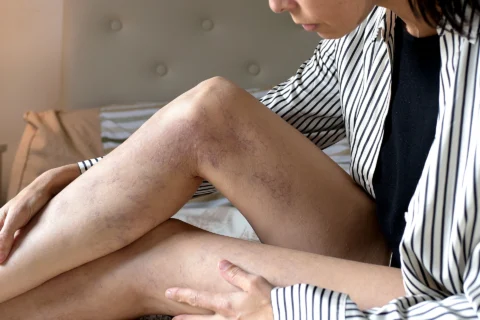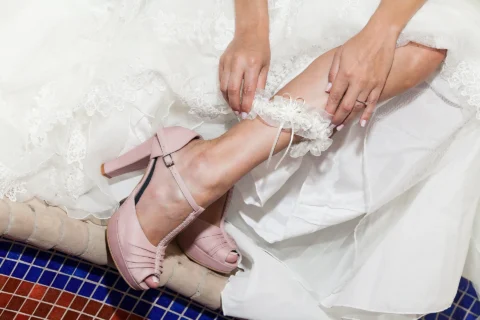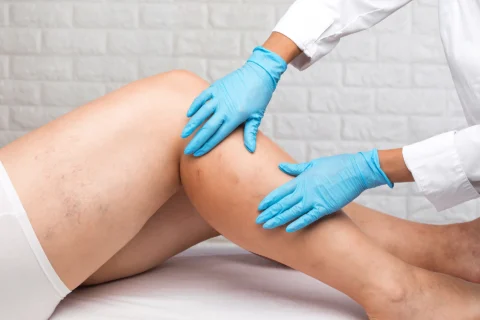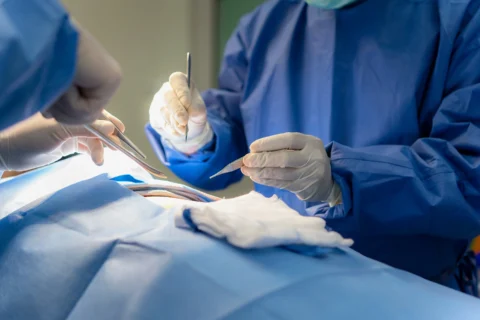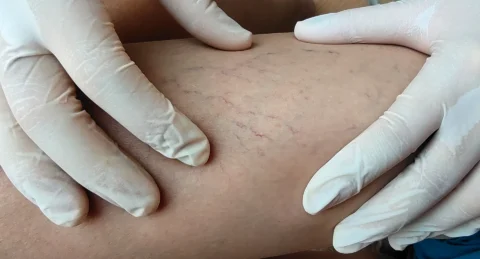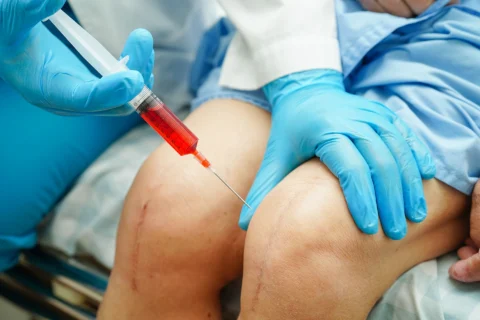Varicose veins are enlarged, overfilled veins that are visible in your skin, which can be both painful and unpleasant looking. This is in contrast with spider veins, an earlier stage of chronic venous insufficiency, which can appear to resemble branches or webs that are colored blue or purple, with red lines sometimes. Additionally, they also appear on different areas of the face and the body.
So when should I get varicose veins treated? If you’re experiencing pain along the area of your unsightly varicose veins, it’s important to have it checked as soon as possible. Unlike spider veins, varicose veins can be caused by underlying health conditions, which can lead to serious medical issues so you must not leave it unchecked.
Should I Get My Varicose Veins Treated Right Away?
Vein conditions usually appear on the leg and facial area, so these are commonly dismissed as mere cosmetic issues. However, there are instances when it’s crucial to have your varicose veins checked because these unsightly veins often lead to serious medical conditions. Below are the instances when you should definitely have your varicose veins treated:
- If you are experiencing pain, burning, or throbbing sensations in the legs
- If you are experiencing muscle cramps in your legs with varicose veins
- If the skin over the varicose veins is itchy and dry
- If your varicose veins are red or warm to the touch
- If there is bleeding, discoloration, and swelling
If bleeding is heavy, seek immediate medical attention upon the visibility of that complication to avoid any adverse event. Varicose veins are so common that millions of people live with it. This condition isn’t always caused by serious health problems, but it’s important to have it checked and treated to rule out any risk of severe complications or underlying conditions.
It’s rare for varicose veins to go away on their own without proper treatment or even just an application of simple home remedies. Although rare, there are instances when only surgical methods performed by a professional vein specialist or vascular surgeon can eliminate these unsightly veins.
One example of this is vein stripping, which is used to remove an affected saphenous vein in your leg as a varicose vein treatment option. But in most cases, extensive but minimally invasive treatments are still needed to completely remove varicose veins.
What Your Varicose Veins Mean
Veins pump blood back to your heart through one-way valves. However, these valves can become weak or damaged over time, which can cause blood pooling and an enlarged vein. This leads to the appearance of unsightly varicose veins.
Facial veins are usually not detrimental, but varicose veins in the leg (i.e, saphenous vein) are often associated with serious causes or underlying conditions.
Causes of Varicose Veins
There are many causes of varicose veins, but so far genetics is a strong factor that may increase your likelihood of developing these unsightly veins. Approximately half of patients who have varicose veins have a family history of it. There’s also a 90% chance that you’ll also develop varicose veins if both your parents have had it.
Genetics is a major factor, but there are also other factors that may cause varicose veins. Among the most common causes of varicose veins are:
- Old age. Aging can result in weaker and damaged veins.
- Obesity. Being overweight or obese can affect blood flow because excess weight can induce your circulatory system to put in more effort to supply blood around the increased body mass. This pressure on the circulatory system to work harder can lead to damaged valves, which can cause varicose veins.
- Hormonal changes. Hormonal imbalances and fluctuations can affect the blood flow in your body. Additionally, pregnancy hormones can also cause temporary varicose veins to appear.
- Trauma or injuries around the affected vein area. Damage inflicted on an area can cause veins to weaken or fail. This damage can be direct or indirect. For instance, if you have constipation or tumors, the pressure from your condition can cause damage to your veins which can lead to varicose veins.
- Poor lifestyle choices. Unhealthy lifestyle habits can lead to excessive weight gain, which can cause damage to your veins. Prolonged sitting and standing also count as unhealthy lifestyle habits, which can also add pressure to your legs and cause the appearance of varicose veins. Lastly, people who use tobacco products also have an increased likelihood of having varicose veins.
Symptoms of Varicose Veins
Varicose veins are unpleasant-looking veins that resemble branches or webs, usually in the color of blue or purple, with red outlines. These mostly appear in the following areas of the body:
- Face
- Legs
- Arms
- Pelvic area
In rare cases, varicose veins may also appear in the testicles, which can definitely lead to infertility. Varicose veins in the leg (i.e, leg veins) are often accompanied by symptoms such as bleeding, ulcers, and blood clot among many others.
Symptomatic varicose veins can further develop into more painful conditions, so it’s best to have it treated as soon as possible. Furthermore, the most recognizable symptoms of varicose veins include:
- Web-like bulging veins
- Heavy or tired legs
- Itching around the affected area
- Pain around the affected area
- Swelling, skin discolorations, and ulcers
Always check if there are changes in your varicose veins. Sometimes you may notice larger varicose veins that bulge as a result of worsening varicose veins conditions or vein disease. Don’t ignore symptomatic varicose veins, make sure to have it treated as soon as you can.
What Happens if You Don’t Treat Varicose Veins

Varicose veins aren’t usually dangerous or caused by long-term medical conditions, but unlike spider veins, it’s not always the case that varicose veins are simple cosmetic conditions.
Varicose veins can lead to serious medical conditions if left untreated, it can also become worse and cause excessive discomfort over time. Additionally, the appearance and symptoms of varicose veins can also be indicative of an underlying health condition such as the following:
- Leg infection
- Open sores
- Blood clots
Some of the health conditions that you would be at risk of if you have untreated varicose veins are:
- Thrombophlebitis. Thrombophlebitis is blood clots that form inside varicose veins if it’s not addressed properly. This superficial vein condition is painful, but it’s not usually dangerous and it’s treatable.
- Deep vein thrombosis. This is a blood clot that isn’t as superficial as thrombophlebitis. People with varicose veins are at high risk for deep vein thrombosis which is a blood clot that occurs in a vein deep inside your body.
- Pulmonary embolism. This can be a further complication of deep vein thrombosis, which is a blood clot that occurs in your lung. Additionally, pulmonary embolism requires immediate medical attention because it’s a life-threatening condition.
- Chronic venous insufficiency. Varicose veins that appear to be severe may be caused by a venous disease called chronic venous insufficiency. As this condition affects the pumping capacity of your veins, it’s important to have it diagnosed and treated by a vein specialist.
Who Are Vulnerable to Varicose Veins?
Varicose veins are common, with at least ⅓ of adults having it. However, women tend to develop varicose veins more often, particularly those located in the lower leg area, though men are also vulnerable. Additionally, this condition is also common in adults because varicose veins are often associated with the weakening of the valves caused by old age.
Furthermore, being pregnant and having excess weight also puts you at risk for varicose veins. Fortunately, varicose veins are commonly temporary for pregnant women, but continuous unhealthy lifestyles and obesity may challenge the duration of the existence of these varicose veins.
High-Quality Varicose Vein Treatments at Vein Center Doctor
Varicose veins are characterized by their unsightly appearance, so you can already self-diagnose that you have this condition from their visibility within the surface of the skin. However, you still need to have it checked by a professional vein specialist so they can rule out any possible underlying condition and provide you with the most suitable varicose vein treatment for you.
A physical examination or ultrasound can be used hand in hand to check your veins for any possible complications and serious health issues that may be associated with your varicose veins. Avoid the risk of further consequences of untreated varicose veins by having yourself checked and getting the right varicose veins treatment option for you.
There are many varicose vein treatment options, which can either be surgical or non-surgical. But at Vein Center Doctor, you don’t have to go through invasive varicose vein treatment options like vascular surgery or varicose vein surgery because there are many effective but minimally invasive solutions available in our clinic.
1) Sclerotherapy
Sclerotherapy is an intravenous treatment procedure that involves a salt solution being injected directly into the affected veins. This is a popular varicose vein and spider vein treatment. The salt solution that is injected will irritate the blood vessel lining, which will then cause it to close and redirect blood to healthier veins. Your body then reabsorbs this closed vein after it turns into scar tissue.
2) Radiofrequency Ablation
Radiofrequency ablation is one of the minimally invasive methods to eliminate varicose veins. Using radiofrequency technology, the broken blood vessels are targeted with heat energy. Radiofrequency treatment will eventually cause damage and the development of a scar tissue that will close up the vein and safely redirect blood to healthier blood vessels.
3) Endovenous Laser Treatment
Laser treatment is also another minimally invasive varicose vein treatment. Endovenous laser ablation treatment is performed by specialists in interventional radiology, which uses laser therapy with an ultrasound to guide the laser fiber. This laser fiber then can target heat and close up the damaged veins, while safely redirecting blood to undamaged blood vessels.
4) VenaSeal
VenaSeal is an FDA-approved adhesive or “vein glue” that is injected into the affected vein to close up the damaged blood vessels, allow it to form scar tissue, and redirect blood to healthier blood vessels.
5) Compression Therapy
Compression therapy can be simply done in the comfort of your home. This method is a non-invasive way to speed up the recovery process of the damaged vein by closing it up and forming scar tissue that heals faster with a compression bandage, socks, and stockings.
Additionally, at Vein Center Doctor, state-of-the-art pneumatic compression devices are also used for compression therapy. These compression devices compress your veins and reduce discomfort. Additionally, the compression helps to stop your veins from further stretching and facilitates better blood flow.
Post-Treatment Instructions for Varicose Vein Treatment
Varicose veins can return after some time around the area of the treated vein. Additionally, it’s difficult to fully prevent varicose veins. However, you can reduce the risk of recurrence of your varicose veins through lifestyle changes and home remedies such as the following:
- Reduce long periods of standing to encourage blood flow
- Elevate your feet above the waist to facilitate blood flow back to the heart
- Maintain your weight to avoid obesity and reduce excessive pressure to blood vessels
- Quit smoking and stay active to improve blood circulation
- Wear clothes that aren’t restrictive
- Regularly try out compression stockings
Risk and Side Effects of Varicose Vein Treatments
Varicose veins may be treated with minimally-invasive procedures, but that doesn’t mean that it’s free from side effects. Even after these varicose vein treatments, there is still the risk of varicose veins happening again. Other common side effects of non-invasive varicose vein treatments include:
- Scarring
- Skin burns, redness, or bruising
- Infection
- Nerve injury
- Deep vein thrombosis
- Lumps or hardness
Be Pain-Free with Varicose Vein Treatments at Vein Center Doctor

Treating varicose veins isn’t as complicated as you might think. A combination of minimally-invasive intravenous therapies, state-of-the-art facilities, and professional team members can help you eliminate unsightly and painful veins.
Here at Vein Center Doctor, we treat venous problems whether it’s caused by cosmetic or medical conditions. With countless patients treated for vein specialization, Dr. Rahul Sood leads an experienced team of vein specialists. Be free from vein pain and schedule your appointment with Vein Center Doctor today.


